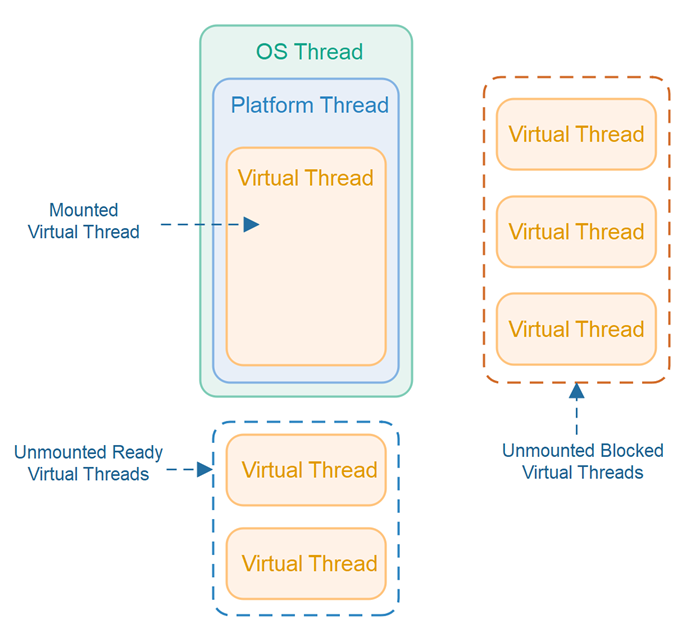The Java ecosystem is in a constant state of evolution, but some releases are more transformative than others. The arrival of Java 21 as a new Long-Term Support (LTS) version marks one of those pivotal moments, fundamentally reshaping how developers approach concurrency. The headline feature, now production-ready and generally available, is Virtual Threads. This innovation, born from Project Loom, is not just an incremental improvement; it’s a paradigm shift that promises to simplify code, dramatically boost application throughput, and solidify Java’s position as a premier platform for building scalable, high-performance systems.
For years, the Java concurrency model has been dominated by platform threads, which are thin wrappers around operating system (OS) threads. While powerful, they are a scarce and heavyweight resource, leading to complex, asynchronous programming models like `CompletableFuture` and the rise of entire ecosystems like Reactive Java. The latest Java 21 news changes this landscape entirely. Virtual threads are lightweight, user-mode threads managed by the JVM, allowing developers to write simple, synchronous-style blocking code that scales massively. This article explores the core concepts, practical implementations, and best practices for leveraging this groundbreaking feature that is set to dominate Java concurrency news for years to come.
Understanding the Concurrency Revolution with Project Loom
To fully appreciate the impact of virtual threads, it’s essential to understand the limitations of the model they are set to replace. The latest Java SE news from Project Loom addresses a core bottleneck that has influenced Java application architecture for over two decades.
The Problem with Platform Threads
Traditionally, every `java.lang.Thread` instance in your application corresponded directly to an OS thread. This one-to-one mapping has significant consequences:
- High Resource Cost: OS threads are expensive. They consume a considerable amount of memory (typically 1-2 MB for stack space) and require a costly context switch by the OS kernel to schedule.
- Limited Scalability: Because they are a finite resource, you can only create a few thousand platform threads before the system becomes overloaded.
- The Rise of Complexity: To work around this limitation, developers adopted non-blocking, asynchronous APIs. This led to callback hell, complex reactive streams, and code that was often difficult to write, debug, and maintain. This is a key reason why the Reactive Java news space grew so rapidly.
The “thread-per-request” model, while simple to reason about, was not scalable with platform threads, forcing a move towards more complex programming paradigms.
Introducing Virtual Threads: Lightweight Concurrency
Virtual threads break the one-to-one mapping. They are managed by the Java Virtual Machine (JVM) itself, which runs them on a small pool of carrier platform threads. When a virtual thread executes a blocking I/O operation (like a network call or database query), the JVM doesn’t block the underlying OS thread. Instead, it “unmounts” the virtual thread, parks it, and makes the carrier thread available to run another virtual thread. Once the I/O operation completes, the JVM “mounts” the virtual thread back onto an available carrier to continue its execution.
This mechanism means you can have millions of virtual threads running concurrently without exhausting system resources. This is a monumental piece of Java performance news, as it allows developers to return to the simple, readable, and maintainable thread-per-request style of code, even for highly concurrent applications.
First Look: Creating Your First Virtual Thread
Java 21 makes creating virtual threads incredibly straightforward. You can use the updated `Thread` class or a new `ExecutorService` factory. This ease of use is a highlight of the current OpenJDK news and is available across all major distributions, from Oracle Java news to builds from Adoptium, Azul, and Amazon.

import java.util.concurrent.Executors;
import java.util.concurrent.TimeUnit;
public class VirtualThreadDemo {
public static void main(String[] args) throws InterruptedException {
System.out.println("Starting main thread: " + Thread.currentThread());
// Method 1: Using Thread.ofVirtual() builder
Thread virtualThread1 = Thread.ofVirtual().name("MyVirtualThread-1").start(() -> {
System.out.println("Running in virtual thread 1: " + Thread.currentThread());
});
// Method 2: Using a dedicated ExecutorService
// This is the preferred approach for managing multiple tasks.
try (var executor = Executors.newVirtualThreadPerTaskExecutor()) {
executor.submit(() -> {
System.out.println("Running task in virtual thread 2: " + Thread.currentThread());
});
executor.submit(() -> {
System.out.println("Running task in virtual thread 3: " + Thread.currentThread());
});
} // The executor is automatically shut down and waits for tasks to complete.
virtualThread1.join(); // Wait for the first virtual thread to finish
System.out.println("Finished main thread.");
}
}
Notice the output will show that `Thread.currentThread()` inside the lambda identifies itself as a `VirtualThread`, distinct from the platform `main` thread.
Putting Virtual Threads to Work: Code and Frameworks
The true power of virtual threads is realized in I/O-bound applications, such as microservices, web applications, and data processing pipelines. The entire Java ecosystem is rapidly adapting, with major Spring news and Jakarta EE news centered around native support for this new concurrency model.
A Practical Use Case: High-Throughput I/O Service
Imagine a service that needs to aggregate data by calling three different downstream APIs. With platform threads, you’d need a carefully sized thread pool and likely use `CompletableFuture` to avoid blocking. With virtual threads, the code becomes elegantly simple and synchronous.
Let’s define a simple interface for a remote data fetcher and a class that uses a virtual thread executor to call multiple fetchers concurrently.
import java.time.Duration;
import java.util.List;
import java.util.concurrent.Executors;
import java.util.stream.Collectors;
// Interface representing a remote data source
interface DataFetcher {
String fetchData() throws InterruptedException;
}
// Service to aggregate data from multiple sources
public class DataAggregatorService {
private final List<DataFetcher> fetchers;
public DataAggregatorService(List<DataFetcher> fetchers) {
this.fetchers = fetchers;
}
// A helper method to simulate a blocking network call
private static String fetchFromApi(String apiName, int delayMillis) throws InterruptedException {
System.out.println("Calling " + apiName + " on " + Thread.currentThread());
Thread.sleep(Duration.ofMillis(delayMillis));
return apiName + " data";
}
public List<String> fetchAllData() {
// Create an executor that spawns a new virtual thread for each task
try (var executor = Executors.newVirtualThreadPerTaskExecutor()) {
// Submit all fetching tasks to run concurrently
var futures = fetchers.stream()
.map(fetcher -> executor.submit(fetcher::fetchData))
.toList();
// Collect the results. The .get() call blocks the virtual thread,
// but not the underlying carrier thread.
return futures.stream()
.map(future -> {
try {
return future.get();
} catch (Exception e) {
throw new RuntimeException(e);
}
})
.collect(Collectors.toList());
}
}
public static void main(String[] args) {
// Define our data fetchers with simulated delays
List<DataFetcher> dataFetchers = List.of(
() -> fetchFromApi("UserAPI", 1000),
() -> fetchFromApi("OrderAPI", 1500),
() -> fetchFromApi("InventoryAPI", 500)
);
DataAggregatorService service = new DataAggregatorService(dataFetchers);
long start = System.currentTimeMillis();
List<String> results = service.fetchAllData();
long duration = System.currentTimeMillis() - start;
System.out.println("Aggregated results: " + results);
// The total time will be close to the longest single call (1500ms),
// not the sum of all calls (3000ms).
System.out.println("Total execution time: " + duration + "ms");
}
}
This code is easy to read and debug. Each task runs on its own virtual thread, and the `future.get()` call blocks in a cheap, scalable way. This is the “structured concurrency” style that virtual threads enable, making it a hot topic in recent Java wisdom tips news.
Spring Boot and Jakarta EE: Embracing the New Paradigm
The framework ecosystem is moving quickly. For example, recent Spring Boot news highlights that Spring Boot 3.2 introduced a simple configuration flag to enable virtual threads for all incoming web requests:
spring.threads.virtual.enabled=true
Setting this in `application.properties` tells the embedded Tomcat server to use a `VirtualThreadPerTaskExecutor`. This means every request is handled by a new virtual thread, instantly boosting the I/O throughput of your controllers without changing a single line of application code. Similarly, the Jakarta EE news space is buzzing with activity as application servers like Helidon and others are integrating virtual threads to simplify asynchronous processing and improve performance for everything from JAX-RS endpoints to message-driven beans.
Beyond the Basics: Structured Concurrency and Scoped Values

While virtual threads are a finalized feature in Java 21, Project Loom has also introduced powerful preview features that complement them: Structured Concurrency and Scoped Values. These address long-standing challenges in concurrent programming related to lifecycle management and data sharing.
Introducing Structured Concurrency
Traditional “fire-and-forget” concurrency with `ExecutorService` can lead to problems like thread leaks, orphaned tasks, and complex error propagation. Structured Concurrency treats a group of related concurrent tasks as a single unit of work. If one task fails, the others can be automatically cancelled. If the main control flow is interrupted, all sub-tasks are reliably terminated.
The `StructuredTaskScope` API (in preview) provides a robust way to implement this. This is the most exciting Java structured concurrency news to come out of the JDK.
import java.time.Instant;
import java.util.concurrent.ExecutionException;
import java.util.concurrent.StructuredTaskScope;
import java.util.function.Supplier;
public class StructuredConcurrencyDemo {
// A task that might fail
Supplier<String> failingTask() {
return () -> {
throw new IllegalStateException("Task failed intentionally at " + Instant.now());
};
}
// A task that succeeds
Supplier<Integer> successfulTask() {
return () -> {
try {
Thread.sleep(1000);
} catch (InterruptedException e) {
// Handle interruption
}
return 42;
};
}
public void runTasks() throws InterruptedException, ExecutionException {
// Create a scope that shuts down on the first failure
try (var scope = new StructuredTaskScope.ShutdownOnFailure()) {
// Fork two tasks to run in parallel on virtual threads
StructuredTaskScope.Subtask<Integer> success = scope.fork(successfulTask());
StructuredTaskScope.Subtask<String> failure = scope.fork(failingTask());
// Wait for all tasks to complete or for one to fail
scope.join();
scope.throwIfFailed(); // Throws an exception if any subtask failed
// This part is unreachable if a task fails
System.out.println("Result from successful task: " + success.get());
System.out.println("Result from 'failing' task: " + failure.get());
} catch (ExecutionException e) {
System.err.println("A task failed, scope has been shut down: " + e.getMessage());
}
}
public static void main(String[] args) throws ExecutionException, InterruptedException {
new StructuredConcurrencyDemo().runTasks();
}
}
In this example, the `failingTask` will throw an exception, causing the `ShutdownOnFailure` scope to immediately cancel the `successfulTask` (by interrupting its thread) and then re-throw the exception from `throwIfFailed()`.
Mastering Virtual Threads: Best Practices and Optimization
Adopting virtual threads requires a slight shift in mindset. Following a few key principles will help you get the most out of this feature and avoid common pitfalls.

Key “Do’s” and “Don’ts”
- DO use virtual threads for I/O-bound or blocking tasks. This is their primary use case.
- DON’T use virtual threads for long-running, CPU-bound tasks. The overhead of unmounting/mounting provides no benefit, and you’re better off using a standard platform thread pool (e.g., `Executors.newFixedThreadPool()`).
- DO NOT pool virtual threads. They are designed to be cheap and short-lived. Creating a new one for each task is the intended pattern. The `newVirtualThreadPerTaskExecutor` embodies this philosophy.
- BEWARE of `synchronized` blocks. If a virtual thread enters a `synchronized` block and then blocks on I/O, it can “pin” the carrier platform thread, preventing it from being used by other virtual threads. Prefer using `java.util.concurrent.locks.ReentrantLock` instead.
Monitoring and The Broader JVM Landscape
Modern tooling is essential for managing millions of threads. The good news in the JVM news space is that tools like Java Flight Recorder (JFR) and standard thread dumps have been updated to handle virtual threads effectively, making it easier to debug and monitor applications at scale. This capability is not limited to one vendor; it’s a core part of the OpenJDK project, meaning you get this benefit whether you use Amazon Corretto news, Azul Zulu news, or builds from Adoptium or BellSoft.
Virtual threads are part of a larger wave of innovation in the Java platform, complementing other major initiatives like Project Panama news (for improved native interoperability) and Project Valhalla news (for advanced memory layouts), all working together to ensure Java remains a top-tier platform for modern application development.
Conclusion: A New Era for Java Concurrency
The general availability of virtual threads in Java 21 is more than just another feature; it’s a fundamental evolution of the Java platform. It brings the simplicity of the thread-per-request model to the scale of modern, I/O-intensive workloads, effectively democratizing high-performance concurrency for all Java developers. By eliminating the need for complex asynchronous code in many common scenarios, developers can write software that is easier to create, read, and maintain.
The key takeaway is this: if your application spends most of its time waiting for network responses or database results, virtual threads are a game-changer. As the ecosystem, from build tools covered in Maven news and Gradle news to frameworks like Spring and Jakarta EE, continues to build on this foundation, the impact will only grow. Now is the time for developers to explore this powerful new capability and rethink how they build scalable applications on the JVM.

